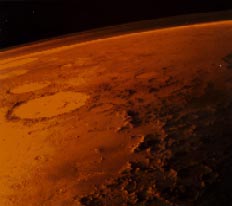

Sequence of Events:
07/04/97 16:38:39 Earth Rise on Mars (Sol 1)
07/04/97 17:02:28 Nominal Entry Point 130 km above Mars
07/04/97 17:03:39 Nominal Time of Peak Atmospheric Heating
07/04/97 17:03:49 Nominal Time of Peak Deceleration
At approximately 16:38:39 the Earth will become visible just over the horizon at the location where Pathfinder will be landing. Approximately four minutes later, the Pathfinder entry capsule will make contract with the outer fringes of the Martian atmosphere at an altitude of 130 kilometers. The Martian atmosphere is quite thin as compared to the Earth's atmosphere. At an altitude of 130 km its pressure is approximately 1/25 that of the Earth's atmosphere. At ground level the Martian atmosphere has a pressure of 6.518 millibars or 0.095 psi as compared to the Earth's sea level atmospheric pressure of 14.7 psi. Peak atmospheric heating occurs at approximately 17:03:39 UTC Earth receive time. At this point the heat shield is preventing the entry capsule from burning up in the atmosphere of Mars. The heat shield is composed of a cork wood, silicate, and epoxy composite that liberates gases upon heating. These gases react with the atmosphere in a catalytic chemical reaction which forms a boundary layer during the ablation of the heat shield. Approximately one minute later, the entry capsule enters a period of peak deceleration. The maximum deceleration rate is 18.6 g's or 182.5 meters per second squared, or 598.9 feet per second squared. If a person who weighed 150 pounds on Earth were seated in the capsule at this point in the entry phase, that person would weigh 2,790 pounds. Our electronics can easily handle this stress, but a person would have difficulty.